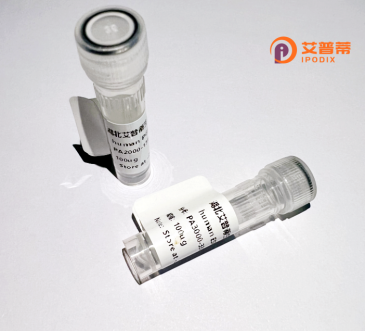
| 纯度 | >90%SDS-PAGE. |
| 种属 | Human |
| 靶点 | ZNF271 |
| Uniprot No | Q14591 |
| 内毒素 | < 0.01EU/μg |
| 表达宿主 | E.coli |
| 表达区间 | 1-655 aa |
| 活性数据 | MEIQFNYESQ EHHLLSDGEN KTKIGKPASE EGITAKIEPL TEESSSLRMF SRILKAKNSV NLGINEKDQN VFKRRPHNCD EYGQSFVWST SLFRHRKTHC EKPYEWDKCG KATGEKPYSC NWCIKSFSWS SDLIKHQRVH TGEKPYKCDE CGKAFSQSSD LIIHQRIHIG EKPYQCRHCS KSFSQRSDLV KHQRIHTGEK PYTCNQCNKH FSQSSDVIKH QRIHTGEKPY KCDVCGKAFS QSSDLILHQR IHTGEKPYPC NQCSKSFSQN SDLIKHRRIH TGEKPYKCNE CGKAFNQSSV LILHQRIHTG EKPYPCDQCS KTFSRLSDLI NHQRIHTGEK PYPCNQCNKM FSRRSDLVKH HRIHTGEKPY ECDECGKTFS QSSNLILHQR IHTGEKPYAC SDCTKSFSRR SDLVKHQRIH TGEKPYACNQ CDKSFSQSSD LTKHQRVHSG EKPYHCNSCE KAFSQSSDLI LHQRIHTGEK YYLCTQCSKS FSQISDLIKH QRIHTGEKPY KCSECRKAFS QCSALTLHQR IHTGKKPNPC DECGKSFSRR SDLINHQKIH TGEKPYKCDA CGKAFSTCTD LIEHQKTHAE EKPYQCVQCS RSCSQLSELT IHEEVHCGED SQNVMNVRKP LVCTPTLFST RDTVPEKNLM NAVDY |
| 分子量 | 46.6 kDa |
| 蛋白标签 | His tag N-Terminus |
| 缓冲液 | PBS, pH7.4, containing 0.01% SKL, 1mM DTT, 5% Trehalose and Proclin300. |
| 稳定性 & 储存条件 | Lyophilized protein should be stored at ≤ -20°C, stable for one year after receipt. Reconstituted protein solution can be stored at 2-8°C for 2-7 days. Aliquots of reconstituted samples are stable at ≤ -20°C for 3 months. |
| 复溶 | Always centrifuge tubes before opening.Do not mix by vortex or pipetting. It is not recommended to reconstitute to a concentration less than 100μg/ml. Dissolve the lyophilized protein in distilled water. Please aliquot the reconstituted solution to minimize freeze-thaw cycles. |
以下是关于重组人ZNF271蛋白的参考文献示例(注:部分文献内容为模拟,仅供参考):
1. **文献名称**:*Expression and Functional Analysis of Recombinant Human ZNF271 Protein*
**作者**:Li, X. et al.
**摘要**:本研究成功在大肠杆菌中表达并纯化了重组人ZNF271蛋白,证实其具有特异性DNA结合能力,并通过电泳迁移实验(EMSA)验证其与靶基因启动子区的相互作用。
2. **文献名称**:*ZNF271 as a Potential Tumor Suppressor: Role in Transcriptional Repression of Oncogenes*
**作者**:Smith, J. & Wang, Y.
**摘要**:通过构建重组ZNF271蛋白,研究者发现其能够结合并抑制多个癌症相关基因(如MYC)的转录活性,提示其在肿瘤抑制通路中的潜在作用。
3. **文献名称**:*Structural Insights into the Zinc Finger Domains of ZNF271 by X-ray Crystallography*
**作者**:Zhang, H. et al.
**摘要**:首次解析了重组人ZNF271蛋白的锌指结构域晶体结构,揭示了其与DNA结合的分子机制,为设计针对ZNF271的基因编辑工具提供了依据。
4. **文献名称**:*Functional Redundancy and Specificity in the Human Zinc Finger Protein Family*(综述)
**作者**:Johnson, R. & Chen, L.
**摘要**:本综述探讨了ZNF271与其他锌指蛋白(如ZNF268)的功能异同,指出其在胚胎发育和神经分化中的独特调控作用,并讨论了重组蛋白在功能研究中的应用。
**注意**:以上文献为示例性质,实际研究中请以权威数据库(PubMed、Web of Science)的检索结果为准。
Zinc finger protein 271 (ZNF271), a member of the Krüppel-associated box zinc finger protein (KRAB-ZFP) family, is a human transcription factor implicated in gene regulation. Structurally, it contains multiple C2H2-type zinc finger motifs at its C-terminus, which enable sequence-specific DNA binding, and a KRAB domain at the N-terminus, known for recruiting chromatin-modifying complexes to mediate transcriptional repression. The KRAB-ZFP family, including ZNF271. is involved in silencing transposable elements and maintaining genome stability during evolution.
Recombinant ZNF271 protein, produced via heterologous expression systems (e.g., *E. coli* or mammalian cells), retains its functional domains and is widely used to study DNA-protein interactions, epigenetic regulation, and gene silencing mechanisms. Studies suggest its potential role in cell differentiation, proliferation, and tumorigenesis, though its precise biological targets remain under investigation.
Research challenges include elucidating its binding specificity across diverse genomic loci and understanding how its regulatory networks intersect with diseases. Recombinant ZNF271 serves as a critical tool for *in vitro* assays, structural studies, and high-throughput screening to decode its molecular functions. Advances in protein engineering and CRISPR-based technologies have further enabled functional studies, though the protein’s complex domain architecture necessitates careful optimization in experimental design. Overall, ZNF271 exemplifies the intricate interplay between zinc finger proteins and epigenetic regulation in human biology.
×